Portfolio Activity 4: Accounting Information System and Profitability
VerifiedAdded on 2021/04/17
|9
|4007
|71
Project
AI Summary
This project proposal examines the relationship between Accounting Information Systems (AIS) and the profitability of businesses. The study aims to understand how AIS impacts a firm's financial performance, decision-making processes, and overall efficiency. The research will employ a mixed-methods approach, combining quantitative and qualitative data collection techniques. The primary research question focuses on the nature of the association between AIS and profitability, while secondary questions delve into the significant features of AIS and its influence on decision-making. The research design will utilize a deductive approach, building upon existing theories and literature. Data collection methods will involve questionnaires distributed via mail and interviews to gather primary data, alongside secondary data from journals, websites, and reports. Purposive sampling will be used to select participants from five UK-based companies. The study will take place in the United Kingdom, with data collection from various sources to minimize bias and ensure access to necessary information. The analysis will involve statistical methods for quantitative data and thematic analysis for qualitative data. The proposal details the research questions, methodology, data collection methods, sampling techniques, and the location of the research, providing a comprehensive overview of the planned investigation into the impact of AIS on firm profitability.
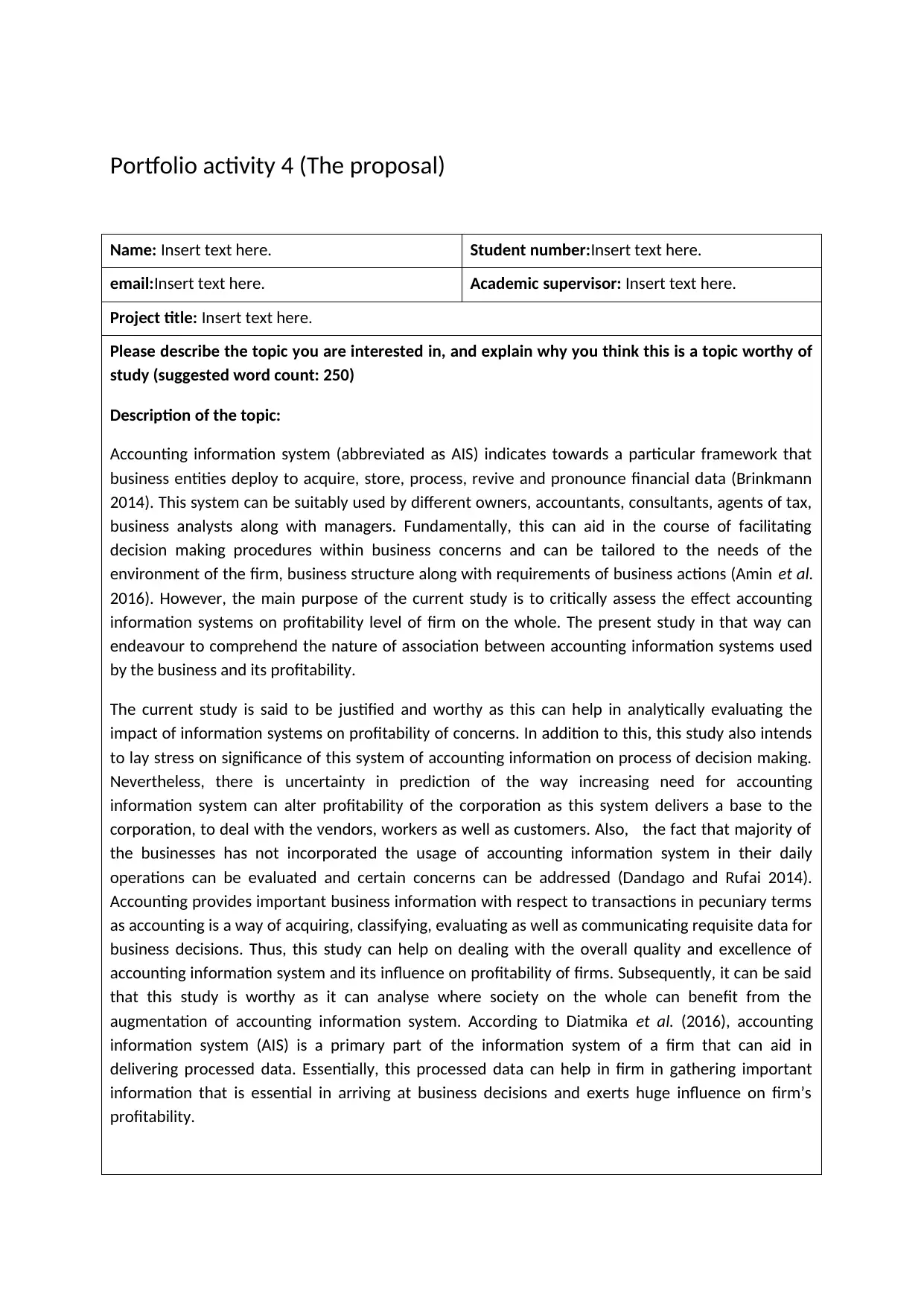
Portfolio activity 4 (The proposal)
Name: Insert text here. Student number:Insert text here.
email:Insert text here. Academic supervisor: Insert text here.
Project title: Insert text here.
Please describe the topic you are interested in, and explain why you think this is a topic worthy of
study (suggested word count: 250)
Description of the topic:
Accounting information system (abbreviated as AIS) indicates towards a particular framework that
business entities deploy to acquire, store, process, revive and pronounce financial data (Brinkmann
2014). This system can be suitably used by different owners, accountants, consultants, agents of tax,
business analysts along with managers. Fundamentally, this can aid in the course of facilitating
decision making procedures within business concerns and can be tailored to the needs of the
environment of the firm, business structure along with requirements of business actions (Amin et al.
2016). However, the main purpose of the current study is to critically assess the effect accounting
information systems on profitability level of firm on the whole. The present study in that way can
endeavour to comprehend the nature of association between accounting information systems used
by the business and its profitability.
The current study is said to be justified and worthy as this can help in analytically evaluating the
impact of information systems on profitability of concerns. In addition to this, this study also intends
to lay stress on significance of this system of accounting information on process of decision making.
Nevertheless, there is uncertainty in prediction of the way increasing need for accounting
information system can alter profitability of the corporation as this system delivers a base to the
corporation, to deal with the vendors, workers as well as customers. Also, the fact that majority of
the businesses has not incorporated the usage of accounting information system in their daily
operations can be evaluated and certain concerns can be addressed (Dandago and Rufai 2014).
Accounting provides important business information with respect to transactions in pecuniary terms
as accounting is a way of acquiring, classifying, evaluating as well as communicating requisite data for
business decisions. Thus, this study can help on dealing with the overall quality and excellence of
accounting information system and its influence on profitability of firms. Subsequently, it can be said
that this study is worthy as it can analyse where society on the whole can benefit from the
augmentation of accounting information system. According to Diatmika et al. (2016), accounting
information system (AIS) is a primary part of the information system of a firm that can aid in
delivering processed data. Essentially, this processed data can help in firm in gathering important
information that is essential in arriving at business decisions and exerts huge influence on firm’s
profitability.
Name: Insert text here. Student number:Insert text here.
email:Insert text here. Academic supervisor: Insert text here.
Project title: Insert text here.
Please describe the topic you are interested in, and explain why you think this is a topic worthy of
study (suggested word count: 250)
Description of the topic:
Accounting information system (abbreviated as AIS) indicates towards a particular framework that
business entities deploy to acquire, store, process, revive and pronounce financial data (Brinkmann
2014). This system can be suitably used by different owners, accountants, consultants, agents of tax,
business analysts along with managers. Fundamentally, this can aid in the course of facilitating
decision making procedures within business concerns and can be tailored to the needs of the
environment of the firm, business structure along with requirements of business actions (Amin et al.
2016). However, the main purpose of the current study is to critically assess the effect accounting
information systems on profitability level of firm on the whole. The present study in that way can
endeavour to comprehend the nature of association between accounting information systems used
by the business and its profitability.
The current study is said to be justified and worthy as this can help in analytically evaluating the
impact of information systems on profitability of concerns. In addition to this, this study also intends
to lay stress on significance of this system of accounting information on process of decision making.
Nevertheless, there is uncertainty in prediction of the way increasing need for accounting
information system can alter profitability of the corporation as this system delivers a base to the
corporation, to deal with the vendors, workers as well as customers. Also, the fact that majority of
the businesses has not incorporated the usage of accounting information system in their daily
operations can be evaluated and certain concerns can be addressed (Dandago and Rufai 2014).
Accounting provides important business information with respect to transactions in pecuniary terms
as accounting is a way of acquiring, classifying, evaluating as well as communicating requisite data for
business decisions. Thus, this study can help on dealing with the overall quality and excellence of
accounting information system and its influence on profitability of firms. Subsequently, it can be said
that this study is worthy as it can analyse where society on the whole can benefit from the
augmentation of accounting information system. According to Diatmika et al. (2016), accounting
information system (AIS) is a primary part of the information system of a firm that can aid in
delivering processed data. Essentially, this processed data can help in firm in gathering important
information that is essential in arriving at business decisions and exerts huge influence on firm’s
profitability.
Paraphrase This Document
Need a fresh take? Get an instant paraphrase of this document with our AI Paraphraser
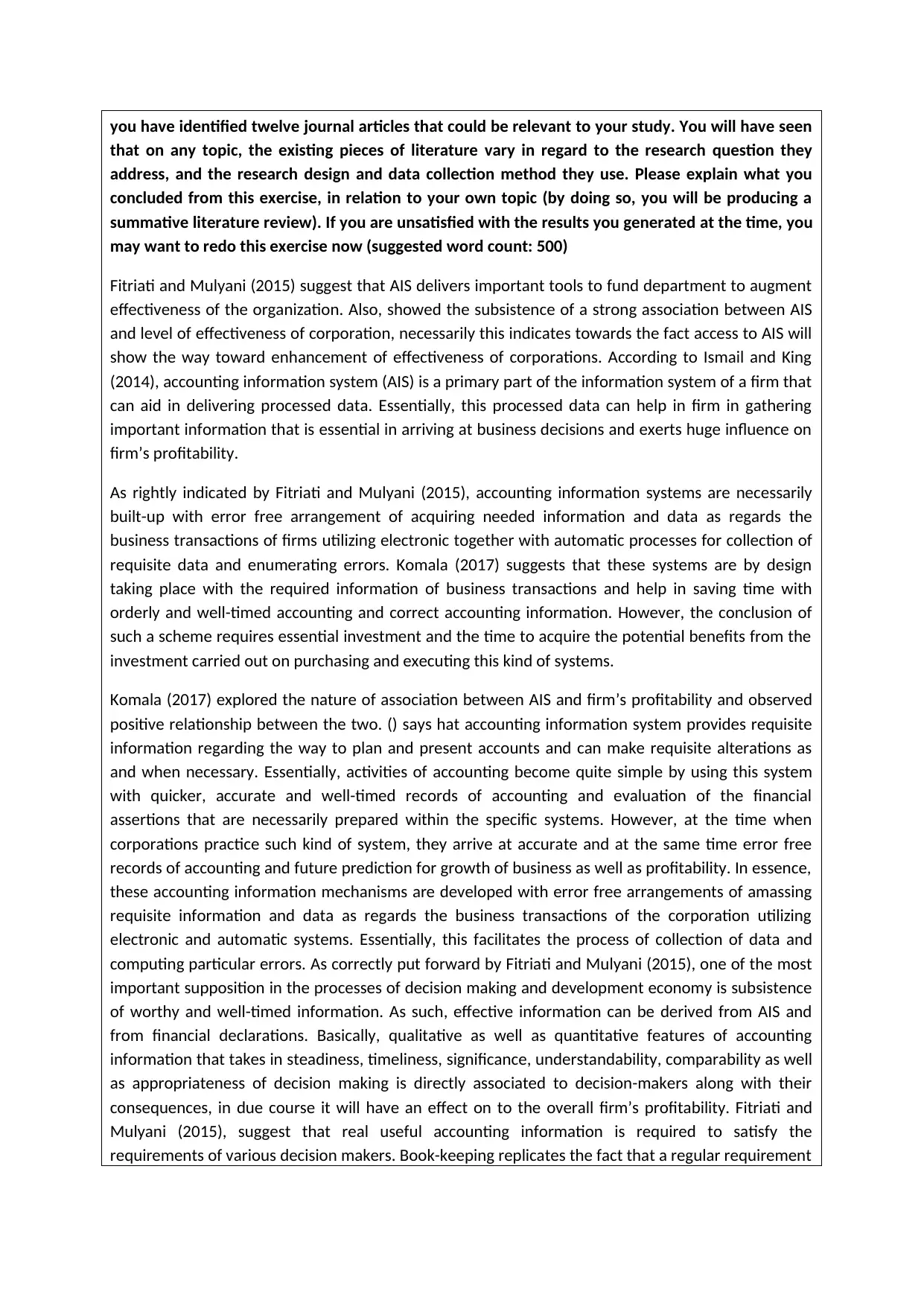
you have identified twelve journal articles that could be relevant to your study. You will have seen
that on any topic, the existing pieces of literature vary in regard to the research question they
address, and the research design and data collection method they use. Please explain what you
concluded from this exercise, in relation to your own topic (by doing so, you will be producing a
summative literature review). If you are unsatisfied with the results you generated at the time, you
may want to redo this exercise now (suggested word count: 500)
Fitriati and Mulyani (2015) suggest that AIS delivers important tools to fund department to augment
effectiveness of the organization. Also, showed the subsistence of a strong association between AIS
and level of effectiveness of corporation, necessarily this indicates towards the fact access to AIS will
show the way toward enhancement of effectiveness of corporations. According to Ismail and King
(2014), accounting information system (AIS) is a primary part of the information system of a firm that
can aid in delivering processed data. Essentially, this processed data can help in firm in gathering
important information that is essential in arriving at business decisions and exerts huge influence on
firm’s profitability.
As rightly indicated by Fitriati and Mulyani (2015), accounting information systems are necessarily
built-up with error free arrangement of acquiring needed information and data as regards the
business transactions of firms utilizing electronic together with automatic processes for collection of
requisite data and enumerating errors. Komala (2017) suggests that these systems are by design
taking place with the required information of business transactions and help in saving time with
orderly and well-timed accounting and correct accounting information. However, the conclusion of
such a scheme requires essential investment and the time to acquire the potential benefits from the
investment carried out on purchasing and executing this kind of systems.
Komala (2017) explored the nature of association between AIS and firm’s profitability and observed
positive relationship between the two. () says hat accounting information system provides requisite
information regarding the way to plan and present accounts and can make requisite alterations as
and when necessary. Essentially, activities of accounting become quite simple by using this system
with quicker, accurate and well-timed records of accounting and evaluation of the financial
assertions that are necessarily prepared within the specific systems. However, at the time when
corporations practice such kind of system, they arrive at accurate and at the same time error free
records of accounting and future prediction for growth of business as well as profitability. In essence,
these accounting information mechanisms are developed with error free arrangements of amassing
requisite information and data as regards the business transactions of the corporation utilizing
electronic and automatic systems. Essentially, this facilitates the process of collection of data and
computing particular errors. As correctly put forward by Fitriati and Mulyani (2015), one of the most
important supposition in the processes of decision making and development economy is subsistence
of worthy and well-timed information. As such, effective information can be derived from AIS and
from financial declarations. Basically, qualitative as well as quantitative features of accounting
information that takes in steadiness, timeliness, significance, understandability, comparability as well
as appropriateness of decision making is directly associated to decision-makers along with their
consequences, in due course it will have an effect on to the overall firm’s profitability. Fitriati and
Mulyani (2015), suggest that real useful accounting information is required to satisfy the
requirements of various decision makers. Book-keeping replicates the fact that a regular requirement
that on any topic, the existing pieces of literature vary in regard to the research question they
address, and the research design and data collection method they use. Please explain what you
concluded from this exercise, in relation to your own topic (by doing so, you will be producing a
summative literature review). If you are unsatisfied with the results you generated at the time, you
may want to redo this exercise now (suggested word count: 500)
Fitriati and Mulyani (2015) suggest that AIS delivers important tools to fund department to augment
effectiveness of the organization. Also, showed the subsistence of a strong association between AIS
and level of effectiveness of corporation, necessarily this indicates towards the fact access to AIS will
show the way toward enhancement of effectiveness of corporations. According to Ismail and King
(2014), accounting information system (AIS) is a primary part of the information system of a firm that
can aid in delivering processed data. Essentially, this processed data can help in firm in gathering
important information that is essential in arriving at business decisions and exerts huge influence on
firm’s profitability.
As rightly indicated by Fitriati and Mulyani (2015), accounting information systems are necessarily
built-up with error free arrangement of acquiring needed information and data as regards the
business transactions of firms utilizing electronic together with automatic processes for collection of
requisite data and enumerating errors. Komala (2017) suggests that these systems are by design
taking place with the required information of business transactions and help in saving time with
orderly and well-timed accounting and correct accounting information. However, the conclusion of
such a scheme requires essential investment and the time to acquire the potential benefits from the
investment carried out on purchasing and executing this kind of systems.
Komala (2017) explored the nature of association between AIS and firm’s profitability and observed
positive relationship between the two. () says hat accounting information system provides requisite
information regarding the way to plan and present accounts and can make requisite alterations as
and when necessary. Essentially, activities of accounting become quite simple by using this system
with quicker, accurate and well-timed records of accounting and evaluation of the financial
assertions that are necessarily prepared within the specific systems. However, at the time when
corporations practice such kind of system, they arrive at accurate and at the same time error free
records of accounting and future prediction for growth of business as well as profitability. In essence,
these accounting information mechanisms are developed with error free arrangements of amassing
requisite information and data as regards the business transactions of the corporation utilizing
electronic and automatic systems. Essentially, this facilitates the process of collection of data and
computing particular errors. As correctly put forward by Fitriati and Mulyani (2015), one of the most
important supposition in the processes of decision making and development economy is subsistence
of worthy and well-timed information. As such, effective information can be derived from AIS and
from financial declarations. Basically, qualitative as well as quantitative features of accounting
information that takes in steadiness, timeliness, significance, understandability, comparability as well
as appropriateness of decision making is directly associated to decision-makers along with their
consequences, in due course it will have an effect on to the overall firm’s profitability. Fitriati and
Mulyani (2015), suggest that real useful accounting information is required to satisfy the
requirements of various decision makers. Book-keeping replicates the fact that a regular requirement
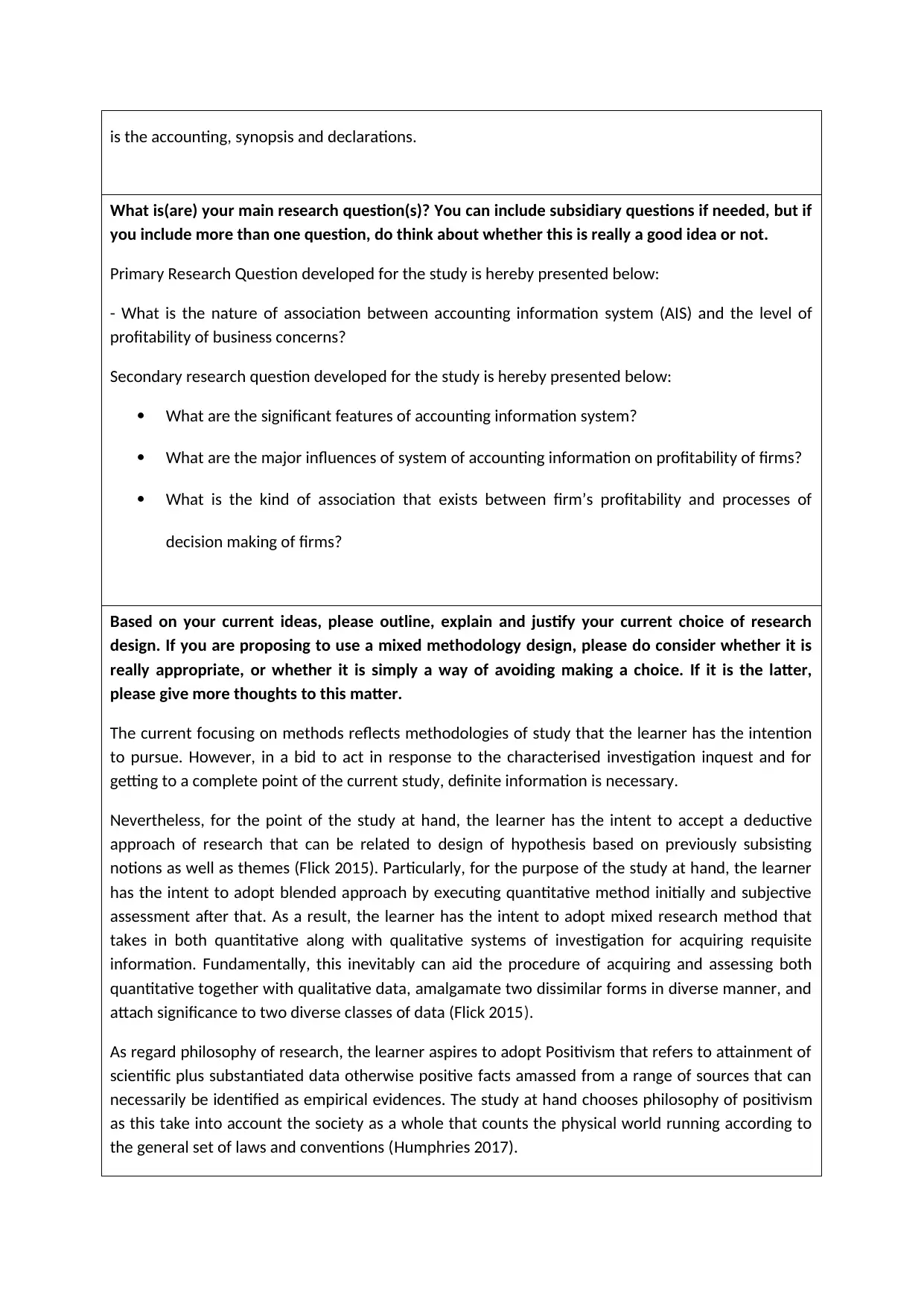
is the accounting, synopsis and declarations.
What is(are) your main research question(s)? You can include subsidiary questions if needed, but if
you include more than one question, do think about whether this is really a good idea or not.
Primary Research Question developed for the study is hereby presented below:
- What is the nature of association between accounting information system (AIS) and the level of
profitability of business concerns?
Secondary research question developed for the study is hereby presented below:
What are the significant features of accounting information system?
What are the major influences of system of accounting information on profitability of firms?
What is the kind of association that exists between firm’s profitability and processes of
decision making of firms?
Based on your current ideas, please outline, explain and justify your current choice of research
design. If you are proposing to use a mixed methodology design, please do consider whether it is
really appropriate, or whether it is simply a way of avoiding making a choice. If it is the latter,
please give more thoughts to this matter.
The current focusing on methods reflects methodologies of study that the learner has the intention
to pursue. However, in a bid to act in response to the characterised investigation inquest and for
getting to a complete point of the current study, definite information is necessary.
Nevertheless, for the point of the study at hand, the learner has the intent to accept a deductive
approach of research that can be related to design of hypothesis based on previously subsisting
notions as well as themes (Flick 2015). Particularly, for the purpose of the study at hand, the learner
has the intent to adopt blended approach by executing quantitative method initially and subjective
assessment after that. As a result, the learner has the intent to adopt mixed research method that
takes in both quantitative along with qualitative systems of investigation for acquiring requisite
information. Fundamentally, this inevitably can aid the procedure of acquiring and assessing both
quantitative together with qualitative data, amalgamate two dissimilar forms in diverse manner, and
attach significance to two diverse classes of data (Flick 2015).
As regard philosophy of research, the learner aspires to adopt Positivism that refers to attainment of
scientific plus substantiated data otherwise positive facts amassed from a range of sources that can
necessarily be identified as empirical evidences. The study at hand chooses philosophy of positivism
as this take into account the society as a whole that counts the physical world running according to
the general set of laws and conventions (Humphries 2017).
What is(are) your main research question(s)? You can include subsidiary questions if needed, but if
you include more than one question, do think about whether this is really a good idea or not.
Primary Research Question developed for the study is hereby presented below:
- What is the nature of association between accounting information system (AIS) and the level of
profitability of business concerns?
Secondary research question developed for the study is hereby presented below:
What are the significant features of accounting information system?
What are the major influences of system of accounting information on profitability of firms?
What is the kind of association that exists between firm’s profitability and processes of
decision making of firms?
Based on your current ideas, please outline, explain and justify your current choice of research
design. If you are proposing to use a mixed methodology design, please do consider whether it is
really appropriate, or whether it is simply a way of avoiding making a choice. If it is the latter,
please give more thoughts to this matter.
The current focusing on methods reflects methodologies of study that the learner has the intention
to pursue. However, in a bid to act in response to the characterised investigation inquest and for
getting to a complete point of the current study, definite information is necessary.
Nevertheless, for the point of the study at hand, the learner has the intent to accept a deductive
approach of research that can be related to design of hypothesis based on previously subsisting
notions as well as themes (Flick 2015). Particularly, for the purpose of the study at hand, the learner
has the intent to adopt blended approach by executing quantitative method initially and subjective
assessment after that. As a result, the learner has the intent to adopt mixed research method that
takes in both quantitative along with qualitative systems of investigation for acquiring requisite
information. Fundamentally, this inevitably can aid the procedure of acquiring and assessing both
quantitative together with qualitative data, amalgamate two dissimilar forms in diverse manner, and
attach significance to two diverse classes of data (Flick 2015).
As regard philosophy of research, the learner aspires to adopt Positivism that refers to attainment of
scientific plus substantiated data otherwise positive facts amassed from a range of sources that can
necessarily be identified as empirical evidences. The study at hand chooses philosophy of positivism
as this take into account the society as a whole that counts the physical world running according to
the general set of laws and conventions (Humphries 2017).
⊘ This is a preview!⊘
Do you want full access?
Subscribe today to unlock all pages.

Trusted by 1+ million students worldwide
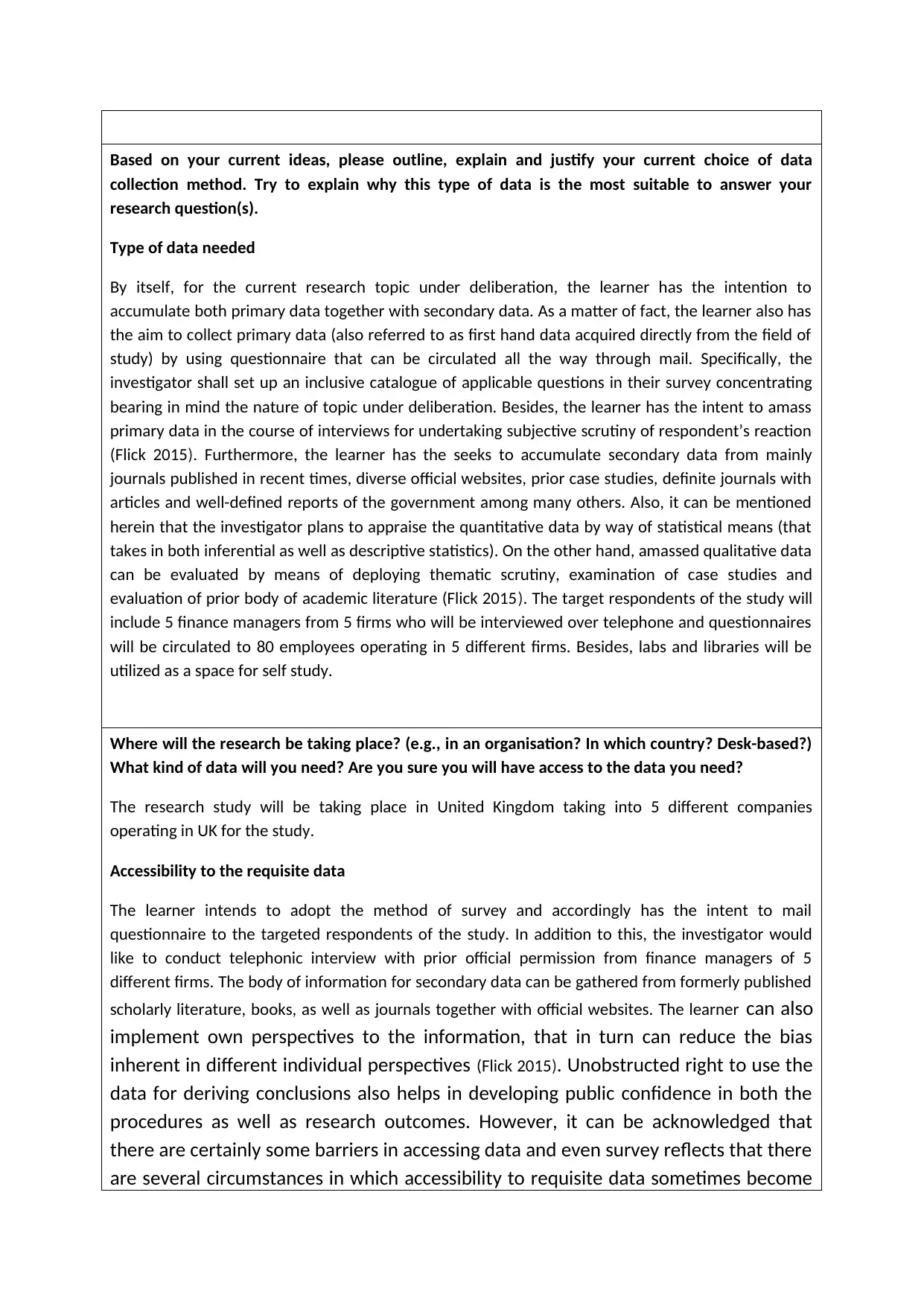
Based on your current ideas, please outline, explain and justify your current choice of data
collection method. Try to explain why this type of data is the most suitable to answer your
research question(s).
Type of data needed
By itself, for the current research topic under deliberation, the learner has the intention to
accumulate both primary data together with secondary data. As a matter of fact, the learner also has
the aim to collect primary data (also referred to as first hand data acquired directly from the field of
study) by using questionnaire that can be circulated all the way through mail. Specifically, the
investigator shall set up an inclusive catalogue of applicable questions in their survey concentrating
bearing in mind the nature of topic under deliberation. Besides, the learner has the intent to amass
primary data in the course of interviews for undertaking subjective scrutiny of respondent’s reaction
(Flick 2015). Furthermore, the learner has the seeks to accumulate secondary data from mainly
journals published in recent times, diverse official websites, prior case studies, definite journals with
articles and well-defined reports of the government among many others. Also, it can be mentioned
herein that the investigator plans to appraise the quantitative data by way of statistical means (that
takes in both inferential as well as descriptive statistics). On the other hand, amassed qualitative data
can be evaluated by means of deploying thematic scrutiny, examination of case studies and
evaluation of prior body of academic literature (Flick 2015). The target respondents of the study will
include 5 finance managers from 5 firms who will be interviewed over telephone and questionnaires
will be circulated to 80 employees operating in 5 different firms. Besides, labs and libraries will be
utilized as a space for self study.
Where will the research be taking place? (e.g., in an organisation? In which country? Desk-based?)
What kind of data will you need? Are you sure you will have access to the data you need?
The research study will be taking place in United Kingdom taking into 5 different companies
operating in UK for the study.
Accessibility to the requisite data
The learner intends to adopt the method of survey and accordingly has the intent to mail
questionnaire to the targeted respondents of the study. In addition to this, the investigator would
like to conduct telephonic interview with prior official permission from finance managers of 5
different firms. The body of information for secondary data can be gathered from formerly published
scholarly literature, books, as well as journals together with official websites. The learner can also
implement own perspectives to the information, that in turn can reduce the bias
inherent in different individual perspectives (Flick 2015). Unobstructed right to use the
data for deriving conclusions also helps in developing public confidence in both the
procedures as well as research outcomes. However, it can be acknowledged that
there are certainly some barriers in accessing data and even survey reflects that there
are several circumstances in which accessibility to requisite data sometimes become
collection method. Try to explain why this type of data is the most suitable to answer your
research question(s).
Type of data needed
By itself, for the current research topic under deliberation, the learner has the intention to
accumulate both primary data together with secondary data. As a matter of fact, the learner also has
the aim to collect primary data (also referred to as first hand data acquired directly from the field of
study) by using questionnaire that can be circulated all the way through mail. Specifically, the
investigator shall set up an inclusive catalogue of applicable questions in their survey concentrating
bearing in mind the nature of topic under deliberation. Besides, the learner has the intent to amass
primary data in the course of interviews for undertaking subjective scrutiny of respondent’s reaction
(Flick 2015). Furthermore, the learner has the seeks to accumulate secondary data from mainly
journals published in recent times, diverse official websites, prior case studies, definite journals with
articles and well-defined reports of the government among many others. Also, it can be mentioned
herein that the investigator plans to appraise the quantitative data by way of statistical means (that
takes in both inferential as well as descriptive statistics). On the other hand, amassed qualitative data
can be evaluated by means of deploying thematic scrutiny, examination of case studies and
evaluation of prior body of academic literature (Flick 2015). The target respondents of the study will
include 5 finance managers from 5 firms who will be interviewed over telephone and questionnaires
will be circulated to 80 employees operating in 5 different firms. Besides, labs and libraries will be
utilized as a space for self study.
Where will the research be taking place? (e.g., in an organisation? In which country? Desk-based?)
What kind of data will you need? Are you sure you will have access to the data you need?
The research study will be taking place in United Kingdom taking into 5 different companies
operating in UK for the study.
Accessibility to the requisite data
The learner intends to adopt the method of survey and accordingly has the intent to mail
questionnaire to the targeted respondents of the study. In addition to this, the investigator would
like to conduct telephonic interview with prior official permission from finance managers of 5
different firms. The body of information for secondary data can be gathered from formerly published
scholarly literature, books, as well as journals together with official websites. The learner can also
implement own perspectives to the information, that in turn can reduce the bias
inherent in different individual perspectives (Flick 2015). Unobstructed right to use the
data for deriving conclusions also helps in developing public confidence in both the
procedures as well as research outcomes. However, it can be acknowledged that
there are certainly some barriers in accessing data and even survey reflects that there
are several circumstances in which accessibility to requisite data sometimes become
Paraphrase This Document
Need a fresh take? Get an instant paraphrase of this document with our AI Paraphraser
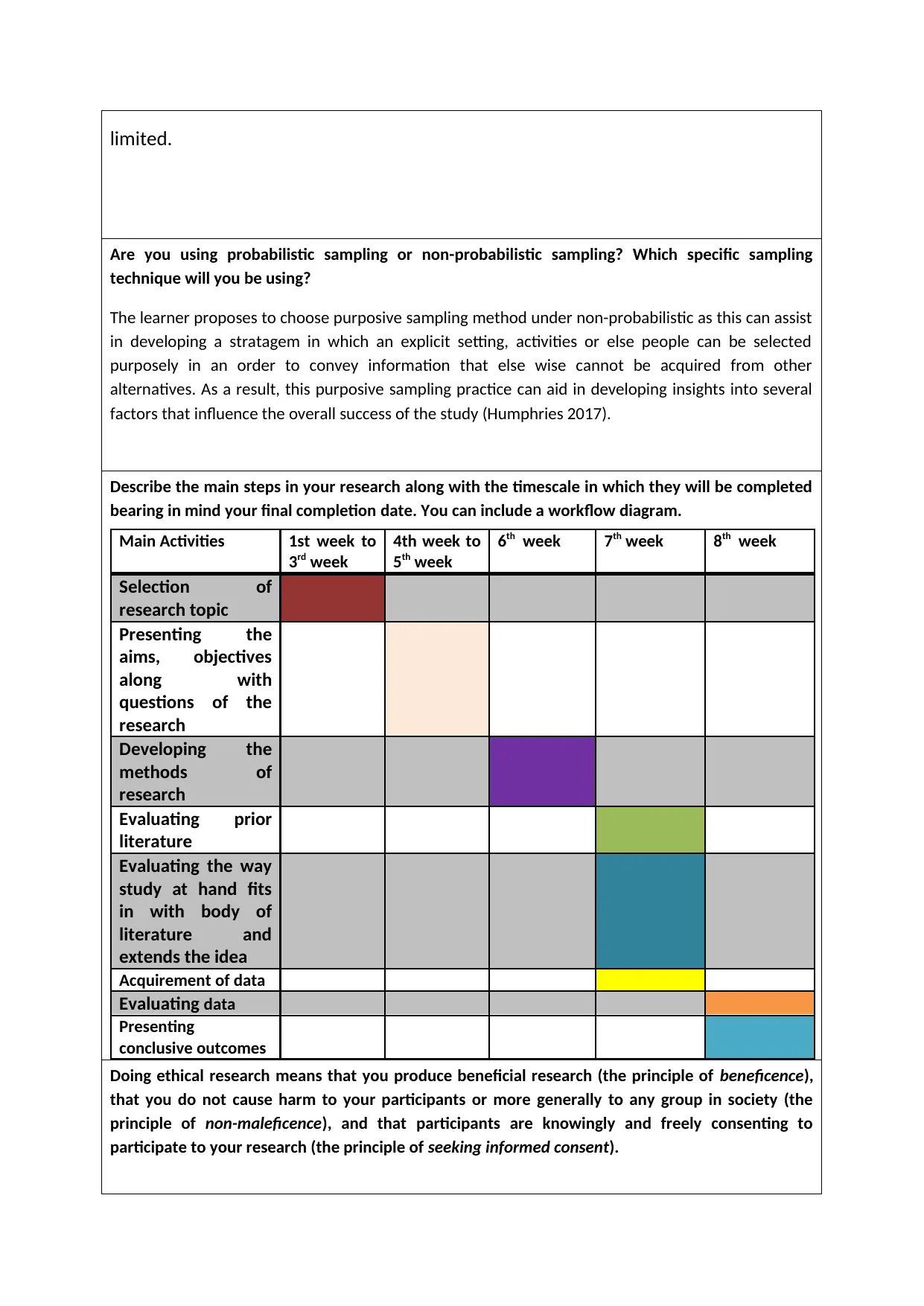
limited.
Are you using probabilistic sampling or non-probabilistic sampling? Which specific sampling
technique will you be using?
The learner proposes to choose purposive sampling method under non-probabilistic as this can assist
in developing a stratagem in which an explicit setting, activities or else people can be selected
purposely in an order to convey information that else wise cannot be acquired from other
alternatives. As a result, this purposive sampling practice can aid in developing insights into several
factors that influence the overall success of the study (Humphries 2017).
Describe the main steps in your research along with the timescale in which they will be completed
bearing in mind your final completion date. You can include a workflow diagram.
Main Activities 1st week to
3rd week
4th week to
5th week
6th week 7th week 8th week
Selection of
research topic
Presenting the
aims, objectives
along with
questions of the
research
Developing the
methods of
research
Evaluating prior
literature
Evaluating the way
study at hand fits
in with body of
literature and
extends the idea
Acquirement of data
Evaluating data
Presenting
conclusive outcomes
Doing ethical research means that you produce beneficial research (the principle of beneficence),
that you do not cause harm to your participants or more generally to any group in society (the
principle of non-maleficence), and that participants are knowingly and freely consenting to
participate to your research (the principle of seeking informed consent).
Are you using probabilistic sampling or non-probabilistic sampling? Which specific sampling
technique will you be using?
The learner proposes to choose purposive sampling method under non-probabilistic as this can assist
in developing a stratagem in which an explicit setting, activities or else people can be selected
purposely in an order to convey information that else wise cannot be acquired from other
alternatives. As a result, this purposive sampling practice can aid in developing insights into several
factors that influence the overall success of the study (Humphries 2017).
Describe the main steps in your research along with the timescale in which they will be completed
bearing in mind your final completion date. You can include a workflow diagram.
Main Activities 1st week to
3rd week
4th week to
5th week
6th week 7th week 8th week
Selection of
research topic
Presenting the
aims, objectives
along with
questions of the
research
Developing the
methods of
research
Evaluating prior
literature
Evaluating the way
study at hand fits
in with body of
literature and
extends the idea
Acquirement of data
Evaluating data
Presenting
conclusive outcomes
Doing ethical research means that you produce beneficial research (the principle of beneficence),
that you do not cause harm to your participants or more generally to any group in society (the
principle of non-maleficence), and that participants are knowingly and freely consenting to
participate to your research (the principle of seeking informed consent).
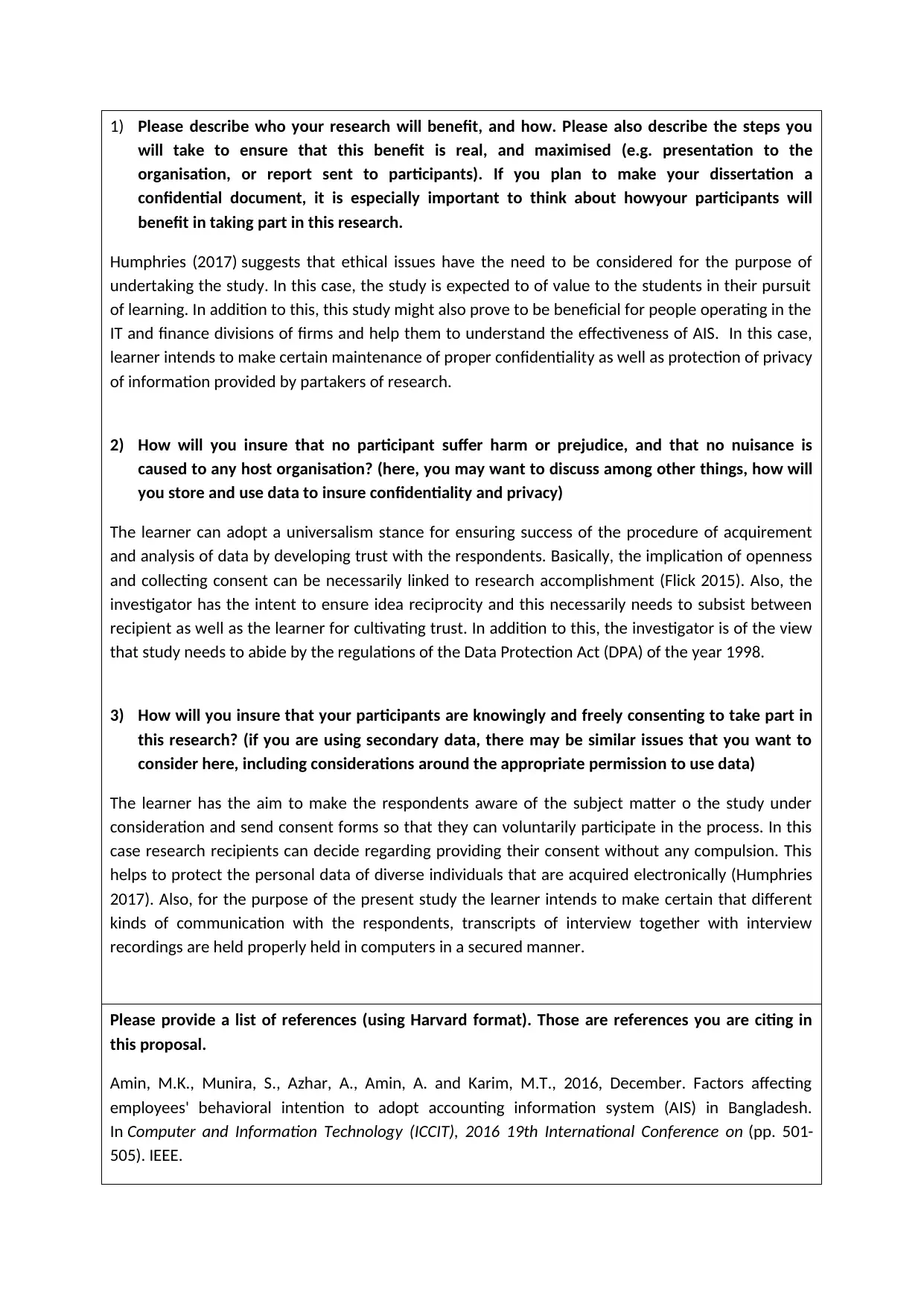
1) Please describe who your research will benefit, and how. Please also describe the steps you
will take to ensure that this benefit is real, and maximised (e.g. presentation to the
organisation, or report sent to participants). If you plan to make your dissertation a
confidential document, it is especially important to think about howyour participants will
benefit in taking part in this research.
Humphries (2017) suggests that ethical issues have the need to be considered for the purpose of
undertaking the study. In this case, the study is expected to of value to the students in their pursuit
of learning. In addition to this, this study might also prove to be beneficial for people operating in the
IT and finance divisions of firms and help them to understand the effectiveness of AIS. In this case,
learner intends to make certain maintenance of proper confidentiality as well as protection of privacy
of information provided by partakers of research.
2) How will you insure that no participant suffer harm or prejudice, and that no nuisance is
caused to any host organisation? (here, you may want to discuss among other things, how will
you store and use data to insure confidentiality and privacy)
The learner can adopt a universalism stance for ensuring success of the procedure of acquirement
and analysis of data by developing trust with the respondents. Basically, the implication of openness
and collecting consent can be necessarily linked to research accomplishment (Flick 2015). Also, the
investigator has the intent to ensure idea reciprocity and this necessarily needs to subsist between
recipient as well as the learner for cultivating trust. In addition to this, the investigator is of the view
that study needs to abide by the regulations of the Data Protection Act (DPA) of the year 1998.
3) How will you insure that your participants are knowingly and freely consenting to take part in
this research? (if you are using secondary data, there may be similar issues that you want to
consider here, including considerations around the appropriate permission to use data)
The learner has the aim to make the respondents aware of the subject matter o the study under
consideration and send consent forms so that they can voluntarily participate in the process. In this
case research recipients can decide regarding providing their consent without any compulsion. This
helps to protect the personal data of diverse individuals that are acquired electronically (Humphries
2017). Also, for the purpose of the present study the learner intends to make certain that different
kinds of communication with the respondents, transcripts of interview together with interview
recordings are held properly held in computers in a secured manner.
Please provide a list of references (using Harvard format). Those are references you are citing in
this proposal.
Amin, M.K., Munira, S., Azhar, A., Amin, A. and Karim, M.T., 2016, December. Factors affecting
employees' behavioral intention to adopt accounting information system (AIS) in Bangladesh.
In Computer and Information Technology (ICCIT), 2016 19th International Conference on (pp. 501-
505). IEEE.
will take to ensure that this benefit is real, and maximised (e.g. presentation to the
organisation, or report sent to participants). If you plan to make your dissertation a
confidential document, it is especially important to think about howyour participants will
benefit in taking part in this research.
Humphries (2017) suggests that ethical issues have the need to be considered for the purpose of
undertaking the study. In this case, the study is expected to of value to the students in their pursuit
of learning. In addition to this, this study might also prove to be beneficial for people operating in the
IT and finance divisions of firms and help them to understand the effectiveness of AIS. In this case,
learner intends to make certain maintenance of proper confidentiality as well as protection of privacy
of information provided by partakers of research.
2) How will you insure that no participant suffer harm or prejudice, and that no nuisance is
caused to any host organisation? (here, you may want to discuss among other things, how will
you store and use data to insure confidentiality and privacy)
The learner can adopt a universalism stance for ensuring success of the procedure of acquirement
and analysis of data by developing trust with the respondents. Basically, the implication of openness
and collecting consent can be necessarily linked to research accomplishment (Flick 2015). Also, the
investigator has the intent to ensure idea reciprocity and this necessarily needs to subsist between
recipient as well as the learner for cultivating trust. In addition to this, the investigator is of the view
that study needs to abide by the regulations of the Data Protection Act (DPA) of the year 1998.
3) How will you insure that your participants are knowingly and freely consenting to take part in
this research? (if you are using secondary data, there may be similar issues that you want to
consider here, including considerations around the appropriate permission to use data)
The learner has the aim to make the respondents aware of the subject matter o the study under
consideration and send consent forms so that they can voluntarily participate in the process. In this
case research recipients can decide regarding providing their consent without any compulsion. This
helps to protect the personal data of diverse individuals that are acquired electronically (Humphries
2017). Also, for the purpose of the present study the learner intends to make certain that different
kinds of communication with the respondents, transcripts of interview together with interview
recordings are held properly held in computers in a secured manner.
Please provide a list of references (using Harvard format). Those are references you are citing in
this proposal.
Amin, M.K., Munira, S., Azhar, A., Amin, A. and Karim, M.T., 2016, December. Factors affecting
employees' behavioral intention to adopt accounting information system (AIS) in Bangladesh.
In Computer and Information Technology (ICCIT), 2016 19th International Conference on (pp. 501-
505). IEEE.
⊘ This is a preview!⊘
Do you want full access?
Subscribe today to unlock all pages.

Trusted by 1+ million students worldwide
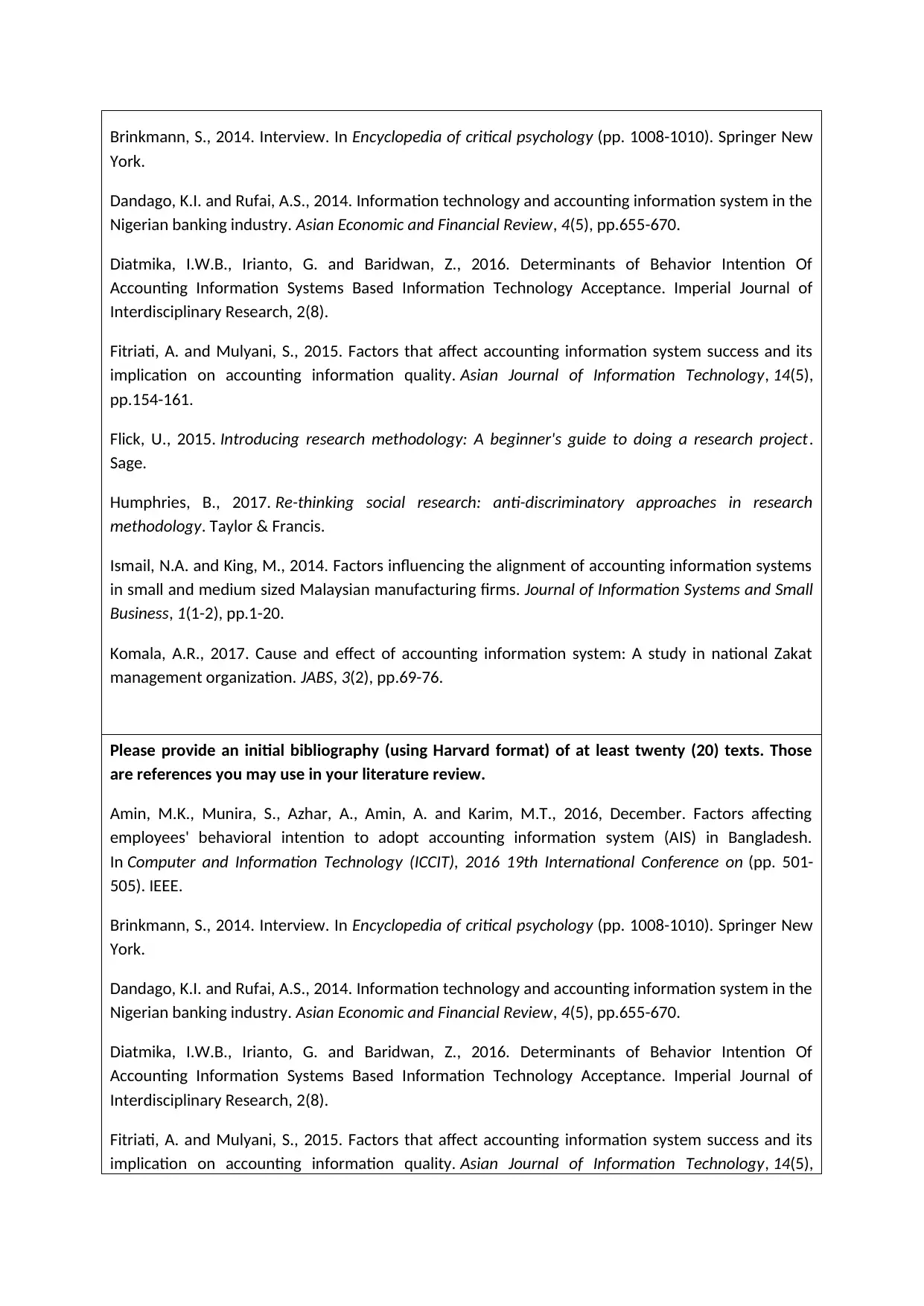
Brinkmann, S., 2014. Interview. In Encyclopedia of critical psychology (pp. 1008-1010). Springer New
York.
Dandago, K.I. and Rufai, A.S., 2014. Information technology and accounting information system in the
Nigerian banking industry. Asian Economic and Financial Review, 4(5), pp.655-670.
Diatmika, I.W.B., Irianto, G. and Baridwan, Z., 2016. Determinants of Behavior Intention Of
Accounting Information Systems Based Information Technology Acceptance. Imperial Journal of
Interdisciplinary Research, 2(8).
Fitriati, A. and Mulyani, S., 2015. Factors that affect accounting information system success and its
implication on accounting information quality. Asian Journal of Information Technology, 14(5),
pp.154-161.
Flick, U., 2015. Introducing research methodology: A beginner's guide to doing a research project.
Sage.
Humphries, B., 2017. Re-thinking social research: anti-discriminatory approaches in research
methodology. Taylor & Francis.
Ismail, N.A. and King, M., 2014. Factors influencing the alignment of accounting information systems
in small and medium sized Malaysian manufacturing firms. Journal of Information Systems and Small
Business, 1(1-2), pp.1-20.
Komala, A.R., 2017. Cause and effect of accounting information system: A study in national Zakat
management organization. JABS, 3(2), pp.69-76.
Please provide an initial bibliography (using Harvard format) of at least twenty (20) texts. Those
are references you may use in your literature review.
Amin, M.K., Munira, S., Azhar, A., Amin, A. and Karim, M.T., 2016, December. Factors affecting
employees' behavioral intention to adopt accounting information system (AIS) in Bangladesh.
In Computer and Information Technology (ICCIT), 2016 19th International Conference on (pp. 501-
505). IEEE.
Brinkmann, S., 2014. Interview. In Encyclopedia of critical psychology (pp. 1008-1010). Springer New
York.
Dandago, K.I. and Rufai, A.S., 2014. Information technology and accounting information system in the
Nigerian banking industry. Asian Economic and Financial Review, 4(5), pp.655-670.
Diatmika, I.W.B., Irianto, G. and Baridwan, Z., 2016. Determinants of Behavior Intention Of
Accounting Information Systems Based Information Technology Acceptance. Imperial Journal of
Interdisciplinary Research, 2(8).
Fitriati, A. and Mulyani, S., 2015. Factors that affect accounting information system success and its
implication on accounting information quality. Asian Journal of Information Technology, 14(5),
York.
Dandago, K.I. and Rufai, A.S., 2014. Information technology and accounting information system in the
Nigerian banking industry. Asian Economic and Financial Review, 4(5), pp.655-670.
Diatmika, I.W.B., Irianto, G. and Baridwan, Z., 2016. Determinants of Behavior Intention Of
Accounting Information Systems Based Information Technology Acceptance. Imperial Journal of
Interdisciplinary Research, 2(8).
Fitriati, A. and Mulyani, S., 2015. Factors that affect accounting information system success and its
implication on accounting information quality. Asian Journal of Information Technology, 14(5),
pp.154-161.
Flick, U., 2015. Introducing research methodology: A beginner's guide to doing a research project.
Sage.
Humphries, B., 2017. Re-thinking social research: anti-discriminatory approaches in research
methodology. Taylor & Francis.
Ismail, N.A. and King, M., 2014. Factors influencing the alignment of accounting information systems
in small and medium sized Malaysian manufacturing firms. Journal of Information Systems and Small
Business, 1(1-2), pp.1-20.
Komala, A.R., 2017. Cause and effect of accounting information system: A study in national Zakat
management organization. JABS, 3(2), pp.69-76.
Please provide an initial bibliography (using Harvard format) of at least twenty (20) texts. Those
are references you may use in your literature review.
Amin, M.K., Munira, S., Azhar, A., Amin, A. and Karim, M.T., 2016, December. Factors affecting
employees' behavioral intention to adopt accounting information system (AIS) in Bangladesh.
In Computer and Information Technology (ICCIT), 2016 19th International Conference on (pp. 501-
505). IEEE.
Brinkmann, S., 2014. Interview. In Encyclopedia of critical psychology (pp. 1008-1010). Springer New
York.
Dandago, K.I. and Rufai, A.S., 2014. Information technology and accounting information system in the
Nigerian banking industry. Asian Economic and Financial Review, 4(5), pp.655-670.
Diatmika, I.W.B., Irianto, G. and Baridwan, Z., 2016. Determinants of Behavior Intention Of
Accounting Information Systems Based Information Technology Acceptance. Imperial Journal of
Interdisciplinary Research, 2(8).
Fitriati, A. and Mulyani, S., 2015. Factors that affect accounting information system success and its
implication on accounting information quality. Asian Journal of Information Technology, 14(5),
Paraphrase This Document
Need a fresh take? Get an instant paraphrase of this document with our AI Paraphraser
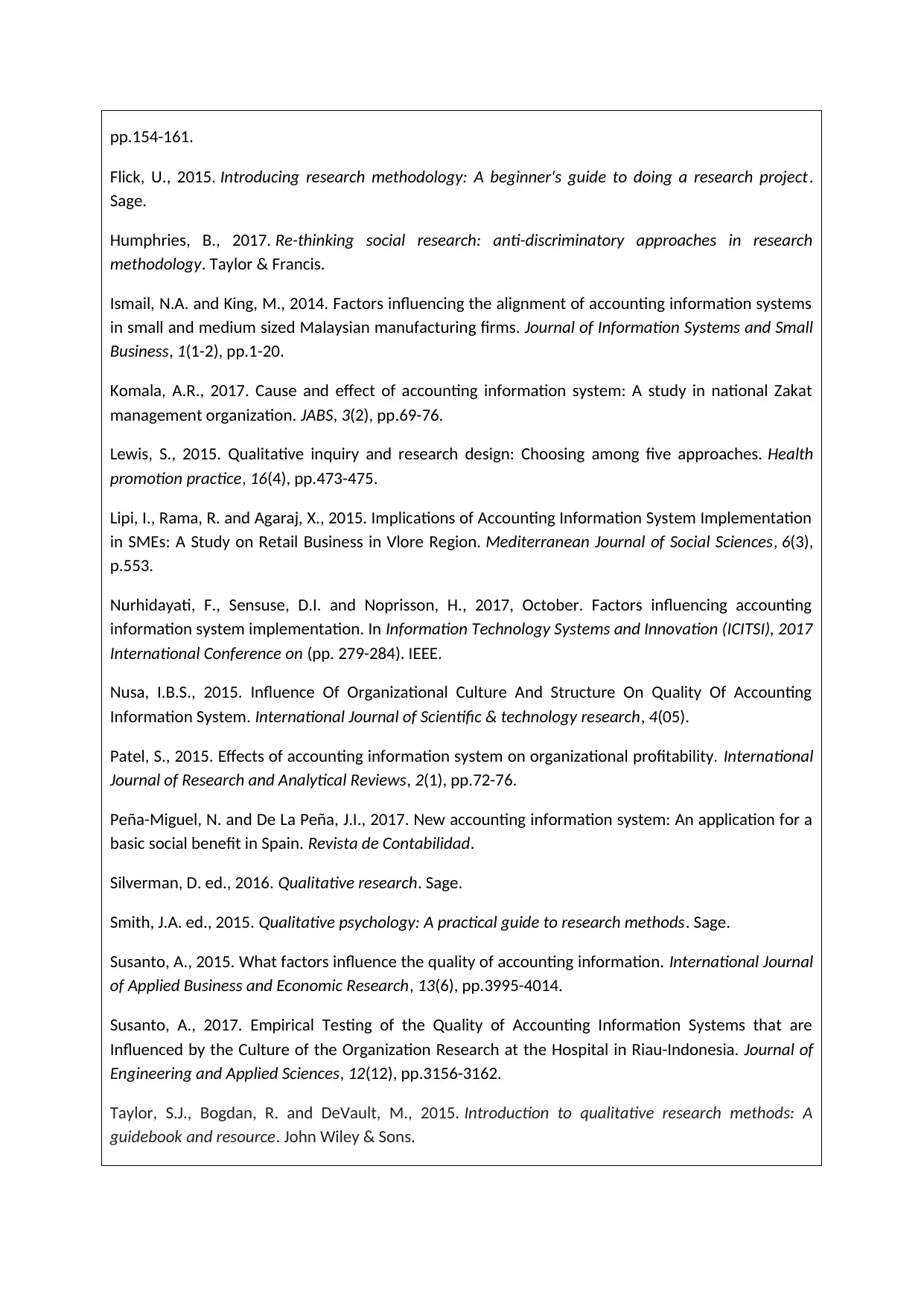
pp.154-161.
Flick, U., 2015. Introducing research methodology: A beginner's guide to doing a research project.
Sage.
Humphries, B., 2017. Re-thinking social research: anti-discriminatory approaches in research
methodology. Taylor & Francis.
Ismail, N.A. and King, M., 2014. Factors influencing the alignment of accounting information systems
in small and medium sized Malaysian manufacturing firms. Journal of Information Systems and Small
Business, 1(1-2), pp.1-20.
Komala, A.R., 2017. Cause and effect of accounting information system: A study in national Zakat
management organization. JABS, 3(2), pp.69-76.
Lewis, S., 2015. Qualitative inquiry and research design: Choosing among five approaches. Health
promotion practice, 16(4), pp.473-475.
Lipi, I., Rama, R. and Agaraj, X., 2015. Implications of Accounting Information System Implementation
in SMEs: A Study on Retail Business in Vlore Region. Mediterranean Journal of Social Sciences, 6(3),
p.553.
Nurhidayati, F., Sensuse, D.I. and Noprisson, H., 2017, October. Factors influencing accounting
information system implementation. In Information Technology Systems and Innovation (ICITSI), 2017
International Conference on (pp. 279-284). IEEE.
Nusa, I.B.S., 2015. Influence Of Organizational Culture And Structure On Quality Of Accounting
Information System. International Journal of Scientific & technology research, 4(05).
Patel, S., 2015. Effects of accounting information system on organizational profitability. International
Journal of Research and Analytical Reviews, 2(1), pp.72-76.
Peña-Miguel, N. and De La Peña, J.I., 2017. New accounting information system: An application for a
basic social benefit in Spain. Revista de Contabilidad.
Silverman, D. ed., 2016. Qualitative research. Sage.
Smith, J.A. ed., 2015. Qualitative psychology: A practical guide to research methods. Sage.
Susanto, A., 2015. What factors influence the quality of accounting information. International Journal
of Applied Business and Economic Research, 13(6), pp.3995-4014.
Susanto, A., 2017. Empirical Testing of the Quality of Accounting Information Systems that are
Influenced by the Culture of the Organization Research at the Hospital in Riau-Indonesia. Journal of
Engineering and Applied Sciences, 12(12), pp.3156-3162.
Taylor, S.J., Bogdan, R. and DeVault, M., 2015. Introduction to qualitative research methods: A
guidebook and resource. John Wiley & Sons.
Flick, U., 2015. Introducing research methodology: A beginner's guide to doing a research project.
Sage.
Humphries, B., 2017. Re-thinking social research: anti-discriminatory approaches in research
methodology. Taylor & Francis.
Ismail, N.A. and King, M., 2014. Factors influencing the alignment of accounting information systems
in small and medium sized Malaysian manufacturing firms. Journal of Information Systems and Small
Business, 1(1-2), pp.1-20.
Komala, A.R., 2017. Cause and effect of accounting information system: A study in national Zakat
management organization. JABS, 3(2), pp.69-76.
Lewis, S., 2015. Qualitative inquiry and research design: Choosing among five approaches. Health
promotion practice, 16(4), pp.473-475.
Lipi, I., Rama, R. and Agaraj, X., 2015. Implications of Accounting Information System Implementation
in SMEs: A Study on Retail Business in Vlore Region. Mediterranean Journal of Social Sciences, 6(3),
p.553.
Nurhidayati, F., Sensuse, D.I. and Noprisson, H., 2017, October. Factors influencing accounting
information system implementation. In Information Technology Systems and Innovation (ICITSI), 2017
International Conference on (pp. 279-284). IEEE.
Nusa, I.B.S., 2015. Influence Of Organizational Culture And Structure On Quality Of Accounting
Information System. International Journal of Scientific & technology research, 4(05).
Patel, S., 2015. Effects of accounting information system on organizational profitability. International
Journal of Research and Analytical Reviews, 2(1), pp.72-76.
Peña-Miguel, N. and De La Peña, J.I., 2017. New accounting information system: An application for a
basic social benefit in Spain. Revista de Contabilidad.
Silverman, D. ed., 2016. Qualitative research. Sage.
Smith, J.A. ed., 2015. Qualitative psychology: A practical guide to research methods. Sage.
Susanto, A., 2015. What factors influence the quality of accounting information. International Journal
of Applied Business and Economic Research, 13(6), pp.3995-4014.
Susanto, A., 2017. Empirical Testing of the Quality of Accounting Information Systems that are
Influenced by the Culture of the Organization Research at the Hospital in Riau-Indonesia. Journal of
Engineering and Applied Sciences, 12(12), pp.3156-3162.
Taylor, S.J., Bogdan, R. and DeVault, M., 2015. Introduction to qualitative research methods: A
guidebook and resource. John Wiley & Sons.

⊘ This is a preview!⊘
Do you want full access?
Subscribe today to unlock all pages.

Trusted by 1+ million students worldwide
1 out of 9
Related Documents
Your All-in-One AI-Powered Toolkit for Academic Success.
+13062052269
info@desklib.com
Available 24*7 on WhatsApp / Email
![[object Object]](/_next/static/media/star-bottom.7253800d.svg)
Unlock your academic potential
Copyright © 2020–2025 A2Z Services. All Rights Reserved. Developed and managed by ZUCOL.





